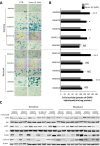Acquired resistance to BRAFi reverses senescence-like phenotype in mutant BRAF melanoma
- PMID: 30159130
- PMCID: PMC6112757
- DOI: 10.18632/oncotarget.25879
Acquired resistance to BRAFi reverses senescence-like phenotype in mutant BRAF melanoma
Abstract
Targeting MAPK pathway in mutant BRAF melanoma with the specific BRAF inhibitor vemurafenib showed robust initial responses in the majority of patients followed by relapses due to acquired resistance to the drug. In V600EBRAF melanoma cell lines, senescence-associated β-galactosidase activity is often encountered in a constitutive manner or induced after MAPK inhibition. However, the link between the senescence-like phenotype and the resistance to BRAF inhibition is not fully understood yet. Our data validate a senescence-like phenotype (low cell proliferation, high cell volume, and high β-Gal activity) in mutant BRAF cells. Vemurafenib increased β-Gal activity in 4 out of 5 sensitive lines and in 2 out of 5 lines with intrinsic resistance to the drug. Interestingly, the 3 lines with acquired resistance to vemurafenib became depending on the drug for proliferation. In absence of drug, these lines showed a lower cell proliferation rate together with a substantial increase of β-Gal activity both in vitro and in vivo. In all settings, the senescence-like phenotype was significantly associated with an inhibition of pRB and cyclin D1, explaining the inhibition of cell proliferation. In conclusion, β-Gal activity is increased by V600EBRAF inhibition in the majority of sensitive and intrinsically resistant melanoma cells. Acquired resistance to vemurafenib is associated with a dependence to the drug for cell proliferation and tumor growth, and, in this case, drug removal stimulate β-Gal activity suggesting that the senescence-like phenotype could contribute to the acquired resistance to BRAF inhibition.
Keywords: V600EBRAF; acquired resistance; melanoma; senescence; vemurafenib.
Conflict of interest statement
CONFLICTS OF INTEREST The authors declare no conflicts of interest.
Figures





References
LinkOut - more resources
Full Text Sources
Other Literature Sources
Research Materials

